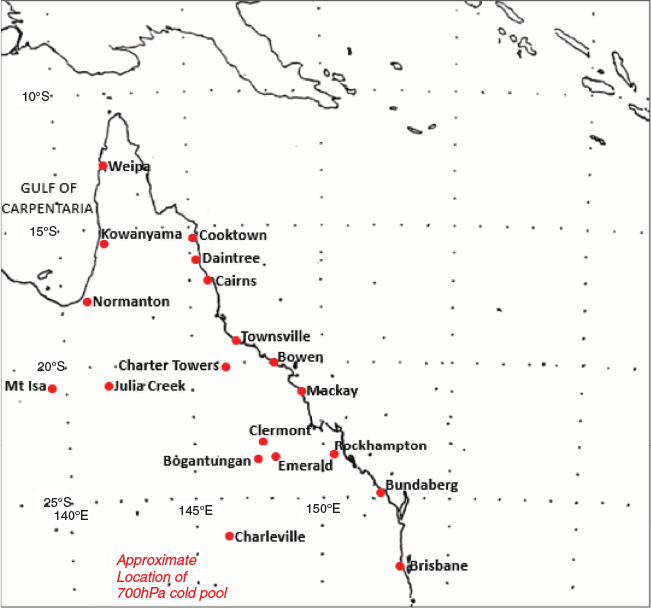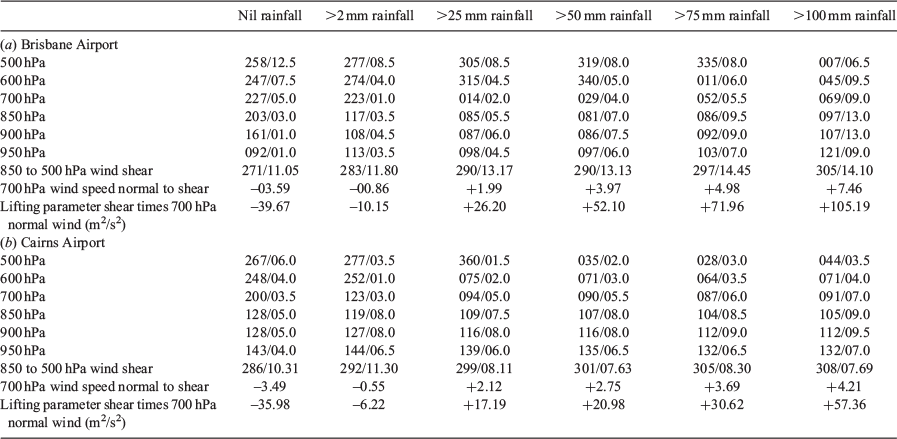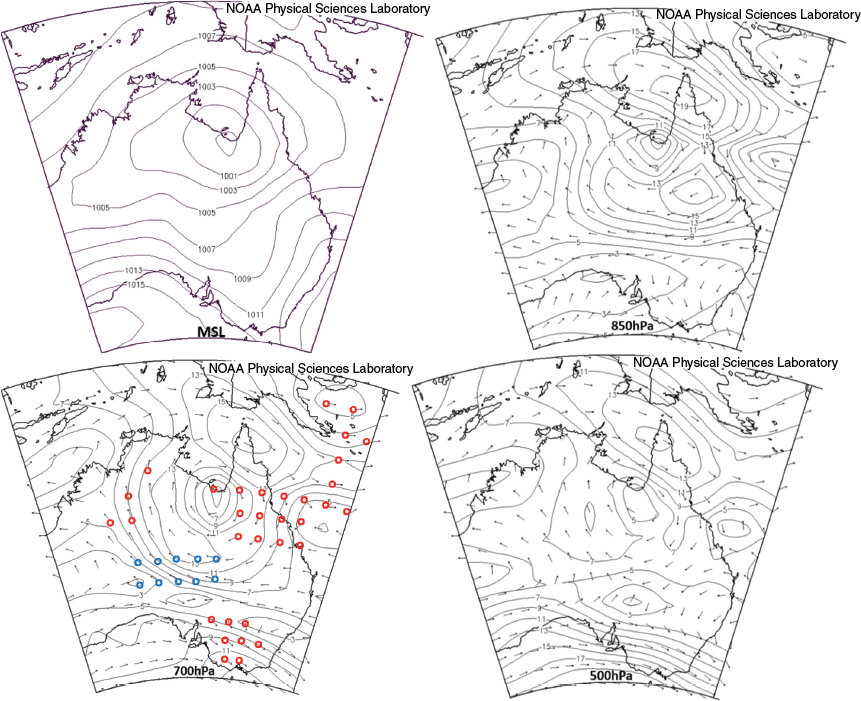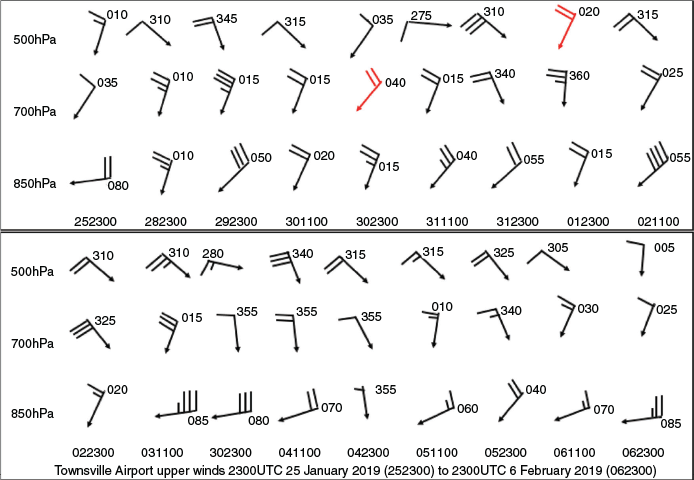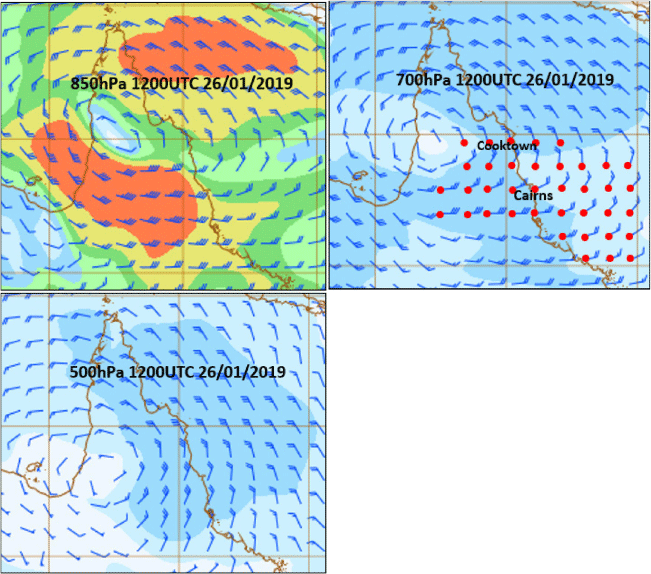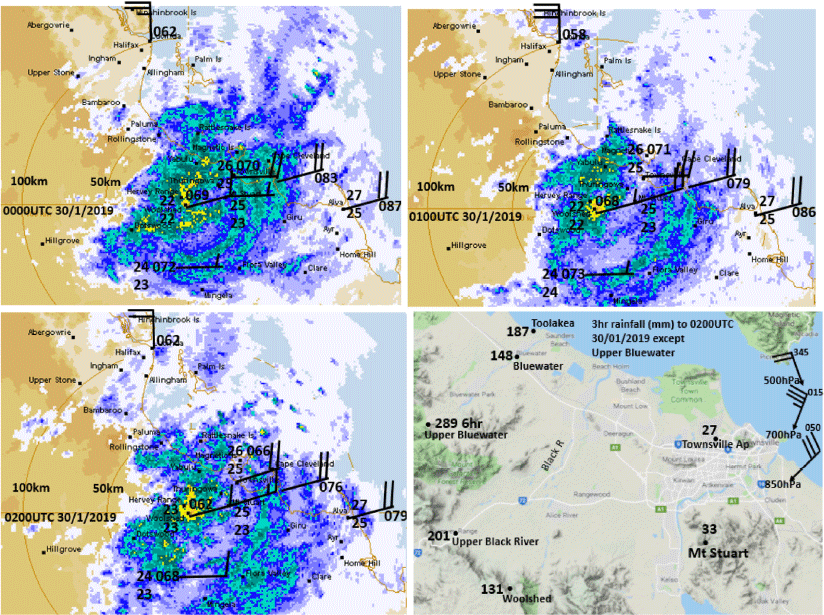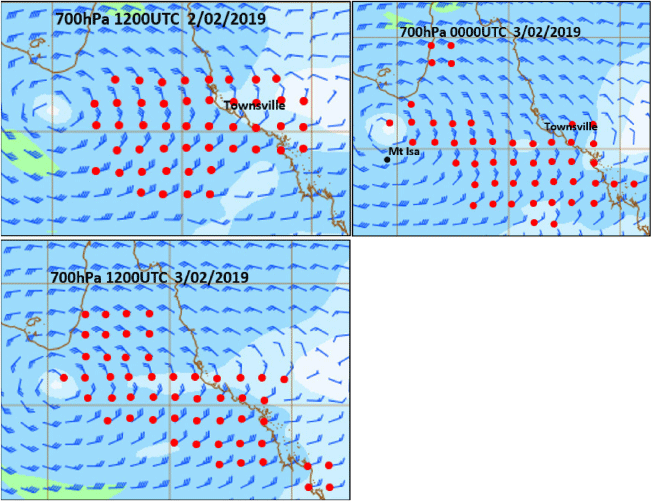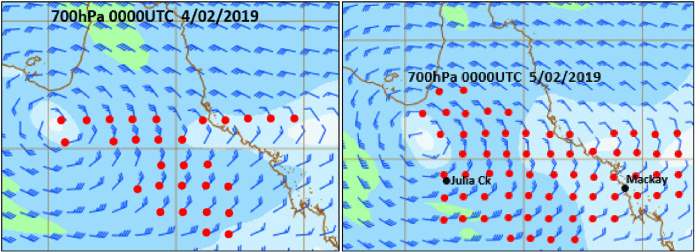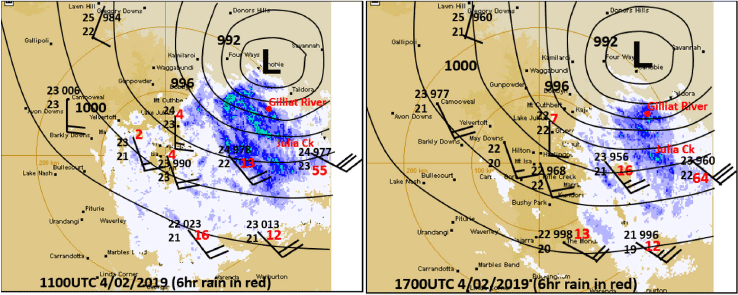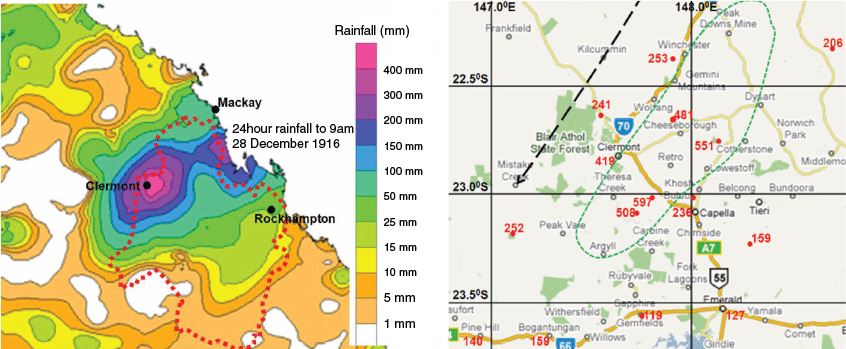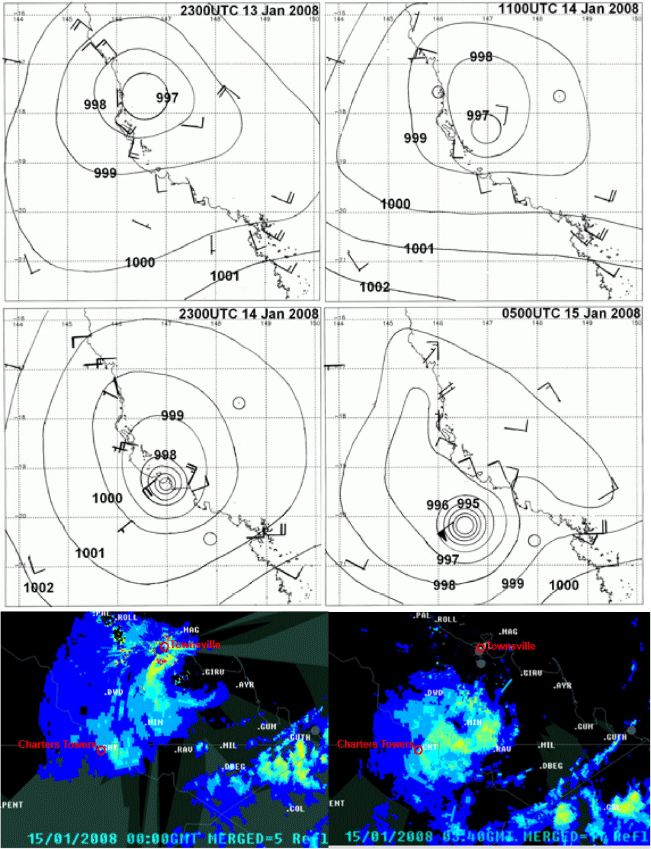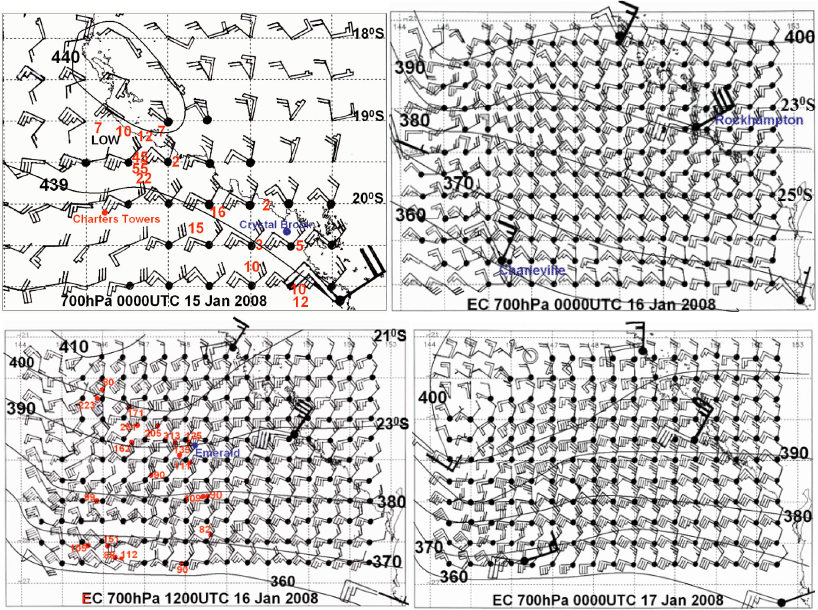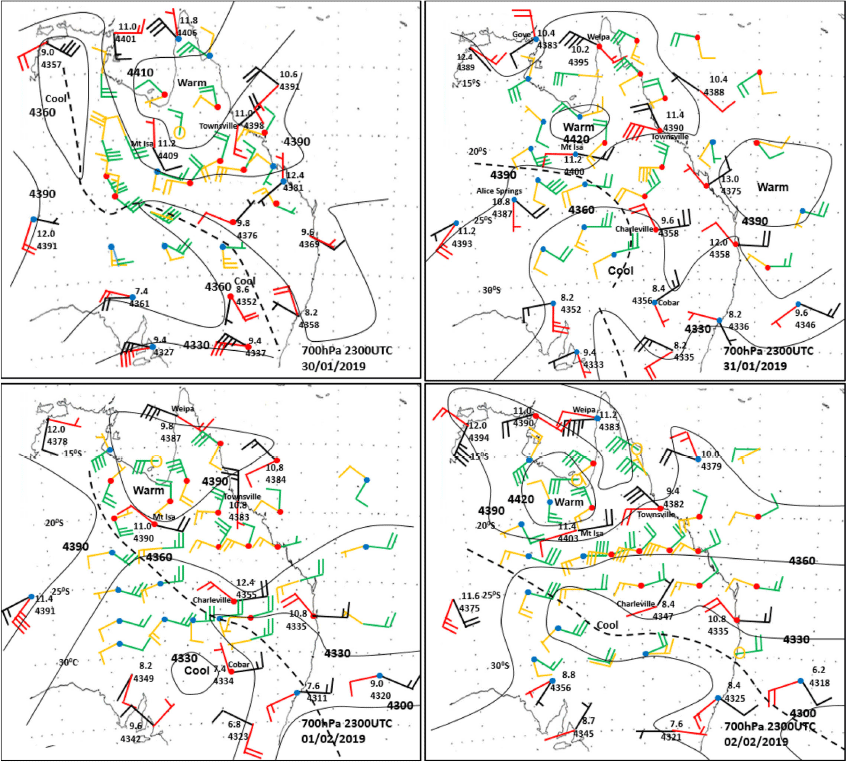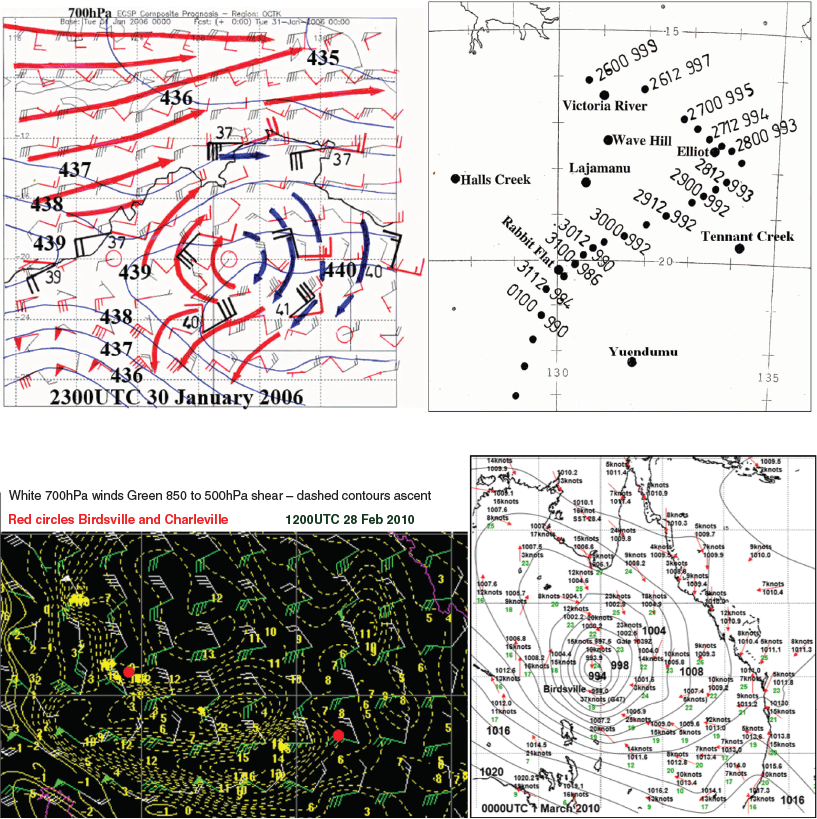Weather systems and extreme rainfall generation in the 2019 north Queensland floods compared with historical north Queensland record floods
Jeff Callaghan
A Retired. Formerly of Bureau of Meteorology Brisbane, Queensland, Australia. Email: jeffjcallaghan@gmail.com
Journal of Southern Hemisphere Earth Systems Science 71(1) 123-146 https://doi.org/10.1071/ES20005
Submitted: 17 August 2020 Accepted: 25 February 2021 Published: 29 March 2021
Journal Compilation © BoM 2021 Open Access CC BY-NC-ND
Abstract
Earlier papers have addressed floods from warm-air advection (WAA) in southeast Australia and around the globe, and extreme rainfall in US hurricanes and Australian tropical cyclones (TCs). This is the first paper to address the WAA phenomena in causing monsoon and TC floods and in TC-like systems which develop over the interior of northern Australia. The inland events help explain Australia’s worst tropical flooding disaster in 1916. A disastrous series of floods during late January and early February 2019 caused widespread damage in tropical north Queensland both in inland regions and along the coast. This occurred when some large-scale climate influences, including the sea surface temperatures suggested conditions would not lead to major flooding. Therefore, it is important to focus on the weather systems to understand the processes that resulted in the extreme rainfall responsible for the flooding. The structure of weather systems in most areas involved a pattern in which the winds turned in an anticyclonic sense as they ascended from the low to middle levels of the atmosphere (often referred to as WAA) which was maintained over large areas for 11 days. HYSPLIT air parcel trajectory observations were employed to confirm these ascent analyses. Examination of a period during which the heaviest rain was reported and compared with climatology showed a much stronger monsoon circulation, widespread WAA through tropical Queensland where normally its descending equivalent of cold-air advection is found, and higher mean sea level pressures along the south Queensland coast. The monsoon low was located between strong deep monsoon westerlies to the north and strong deep easterlies to the south which ensured its slow movement. This non-TC event produced heavy inland rainfall. Extreme inland rainfall is rare in this region. Dare et al. (2012), using data from 1969/70 to 2009/10, showed that over north Queensland non-TC events produced a large percentage of the total rainfall. The vertical structure associated with one of the earlier events that occurred in 2008 had sufficient data to detect strong and widespread WAA overlying an onshore moist tropical airstream. This appears to have played a crucial role in such extreme rainfall extending well inland and perhaps gives insight to the cause of a 1916 flooding disaster at Clermont which claimed around 70 lives. Several other events over the inland Tropics with strong WAA also help explain the 1916 disaster.
Keywords: extreme rainfall, floods, historical records, monsoon rainfall, natural disaster, tropical weather, warm-air advection.
1 Introduction
This is the first paper to address the anticyclonic turning of the winds with height (warm-air advection (WAA) phenomena) in causing monsoon and tropical cyclone (TC) floods in the northeast Australian tropics and in TC-like systems which develop over the interior of northern Australia. We earlier addressed floods from WAA in southeast Australia and around the globe, and extreme rainfall in US hurricanes and Australian TCs.
Inland freshwater flooding can have catastrophic consequences. Czajkowski et al. (2017) showed that freshwater flooding economic losses were twice as high as storm surge losses from all substantial TCs in the US between 2001 and 2014. Furthermore, the losses from inland flooding were nearly as great as those from coastal flooding. From the US National Weather Service web site comes the following warming, ‘In the last 30 years, inland flooding has been responsible for more than half the deaths associated with tropical cyclones in the United States’.
Hurricane Harvey was a catastrophic example of this and is the second-most costly hurricane in US history (Blake and Zelinsky 2018), after accounting for inflation, behind only Katrina (in 2005). At least 68 people died most from freshwater flooding from the direct effects of the storm in Texas, the largest number of direct deaths from a TC in that state since 1919. There were 52 deaths from Hurricane Florence (in 2018), with the majority resulting from freshwater flooding (Stewart and Berg 2019). This makes Florence the ninth-most-destructive hurricane to affect the US. Both these events were associated with isentropic ascent, characterised by a wind structure where the winds turned anticyclonically with height as detailed below. Additionally, the weather systems involved were relatively slow moving.
Another example of extreme tropical rainfall with winds turning anticyclonically with height (Callaghan 2017a) occurred when Mumbai (Santacruz) recorded 944.2 mm in the 24-h period ending 1400UTC 27 July 2005, which was one of the highest daily totals ever recorded in India. Numerical weather forecasting models failed to predict this extreme event (Sahany et al. 2010). There were at least 445 fatalities, with lack of public information apparently adding to the chaos. Radio stations and many television stations claim that they did not receive any weather warnings or alerts by the civic agencies. Anjaria (2006) described problems in managing this disaster.
In this paper, the anticyclonic turning of winds with height is shown to have been a dominant feature of the 2019 north Queensland floods. The Bureau of Meteorology (2019a) produced Special Climate Statement 69, which describes an extended period of record-breaking heavy rainfall and flooding in tropical Queensland which occurred between 26 January and 7 February 2019. A quasi-stationary monsoon depression with flooding extending over this period driving daily rainfall accumulations exceeding 200 mm/day, maximum temperatures 8–10°C below normal and wind gusts above 70 km/h. The event caused the loss of five human lives, flooded thousands of houses and caused livestock losses of more than 664 000. In Townsville alone, the Insurance Council of Australia state that the insurance costs reached at A$1.24 billion, with around 30 000 insurance claims (Australian Financial Review 4 August 2019).
Across the whole of northern Queensland, Deloitte Access Economics 2019 (Ogge 2019) determined that the combined social and economic cost may reach A$5681 million. The results from a study by Adekunle et al. (2019) have consistently shown that a flooding event like this in Townsville is likely to increase the number of mosquito-borne infections and increase the carrying capacity of the vector population and thus affect the health of the population.
The paper is organised as follows with a location map provided in Fig. 1. Data sources are listed in Section 2. Mechanisms causing extreme rainfall are presented in Section 3. Climate drivers and forecast problems are discussed in Section 4. Section 5 describes the 2019 events and in Section 6 this event is compared with the most disastrous historical north Queensland flood events to place the 2019 event into perspective. Rainfall rates in some of these earlier events were greater than those in 2019. This was especially evident about the tropical central interior of Queensland where two events, one causing unprecedented loss of life are described in detail. A conclusion is reached in Section 7.
2 Data
Most of the data come from the Bureau of Meteorology (BOM) website (www.bom.gov.au); however, the following websites were used to obtain data after the event:
archived radar data were obtained from the Weather Chasers web site www.theweatherchaser.com/radar-loop/;
archived synoptic weather observations from www.meteomanz.com/?l=1;
archived upper wind observations from the University of Wyoming website at weather.uwyo.edu/upperair/sounding.html.
Archived European Centre for Medium-Range Weather Forecasts analyses from routinely received analyses at BOM Head Office at the time were used for the January 2008 event.
Seasonal composites (averages) of the mean or anomalies of variables from the United States National Centers for Environmental Prediction (NCEP) reanalysis and other datasets at the following site: https://psl.noaa.gov/cgi-bin/data/composites/printpage.pl/hour/index.html.
The NOAA HYSPLIT model for air parcel trajectory analyses using the Global Data Assimilation System (GDAS) 0.5° global model September 2007 to June 2019 at the following site: https://www.ready.noaa.gov/HYSPLIT.php.
3 Mechanisms which produce extreme rainfall
The extreme rainfall diagnostic used in this paper is based on the thermal wind relationship (e.g. Holton 2004), which has been used to diagnose isentropic ascent and descent regions for decades, in which a component of the geostrophic wind is aligned with the thickness gradient, giving the appearance of WAA and cold-air advection (CAA) respectively. While the common derivation assumes geostrophic and hydrostatic balance, the relationship also holds for gradient wind balance (Tory 2014), which means it is applicable to most intense rain-bearing systems at any latitude. In this paper, WAA is analysed between the 850 and 500 hPa levels representing much of the lower troposphere. When sufficient moisture is present, widespread isentropic ascent in this layer often triggers broadscale and persistent convective rainfall.
The presence of the WAA wind structure in heavy rain-bearing systems is quite common, and the causal relationship well established. As stated above, the disastrous freshwater flooding associated with Hurricanes Harvey and Florence and the 2005 Mumbai floods were associated with WAA winds (Callaghan 2017a, 2018, 2020). Goff and Hanson (2012) found this to be the case in the middle latitudes of the US. Previous studies (Bonell et al. 2005; Bonell and Callaghan 2008; Callaghan and Tory 2014; Tory 2014; Callaghan and Power 2016) examined winds associated with extreme rainfall in both the tropics and the mid-latitudes of Australia. Further studies (Callaghan 2017a, 2019) found this to apply in many cases around the globe. Theoretical arguments (Tory 2014) suggest, assuming gradient wind balance, that isentropic uplift is likely to be associated with winds that turn anticyclonically with height in most heavy rain-bearing systems, including the tropics and subtropics. Two Australian studies (Callaghan and Power 2014, 2016) examined extreme rainfall and major flooding events in coastal catchments and more broadly over southeastern Australia. Using radiosonde and reanalysis data they examined the vertical structure of these systems in the period for which upper wind data became available. In every case (i) atmospheric moisture content was high and (ii) the low-level winds were onshore, and in almost every case (iii) the wind-direction turned anticyclonically with increasing height up to 500 hPa. Further details of this wind structure can be found in Callaghan and Power (2016).
Table 1 illustrates, using a greater than 50-year climatology, how heavy rainfall results from a WAA wind profile both in the deep tropics (at Cairns) and in the subtropics (at Brisbane). The response is greater at Cairns as the winds are lighter and the 700 hPa wind component normal to the 850 to 500 hPa shears are lighter signifying weaker WAA. Thus, the response to a weak temperature gradient at 700 hPa in the tropics, where there is more available moisture, is greater than that at high latitudes.
The other factor critical to the disastrous effects of the 2019 floods was the slow movement of the monsoon low. The monsoon low was located between strong deep monsoon westerlies to the north and strong deep easterlies to the south giving it a relatively symmetric structure which ensured its slow movement (more details of this are shown below).
The common summer wind pattern in north Queensland is a CAA wind structure which contributes to convective suppression. This is illustrated in Fig. 2, which shows the winds turning clockwise (cyclonic) with height over much of the state on average through January, February and March (see https://psl.noaa.gov/data/composites/day/). The rainfall associated with this pattern is heavy rain in the monsoon trough across the Gulf of Carpentaria and Cape York and light rainfall further south.
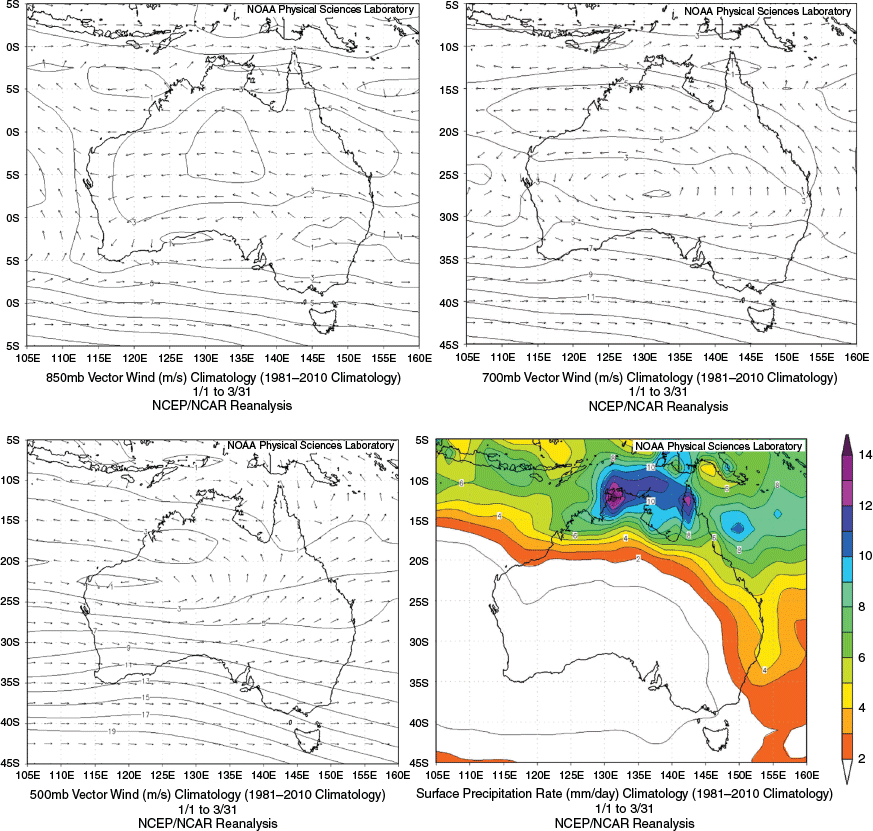
|
In the Queensland Severe Weather Section, we observed this daily especially from the 1990s onwards when we had access to numerical weather prediction models such as that from the European Centre model. The author spent the active 1973/1974 summer on Willis Island Meteorological Station and with monotonous regularity the radar balloon flight showed low-level southeast winds turning clockwise with height through southerly winds up to south-westerly at 500 hPa. During this time only light rainfall was observed. It was only when a vortex developed, or an upper trough system extended up into the tropics (see example Appendix 1) that a WAA pattern and heavy rainfall was observed.
A WAA pattern occurred during a short period in 2019 and is illustrated in Fig. 3. This shows an intense monsoon low in the southeast Gulf of Carpentaria, the 850 hPa monsoon winds peak at over 19 m/s over Cape York Peninsula and strong east to northeasterlies at over 16 m/s south of the monsoon trough. At 500 hPa a trough system was located through western Queensland, producing WAA at 700 hPa over much of tropical Queensland. The 500 hPa trough over western Queensland helped produce thunderstorm activity in that region. The evolution of a cold pool just west of the Charleville to Cobar region that contributed to the WAA is described in Appendix 1. Mean sea level pressures over southeast Queensland were a little stronger than climatology so the strong east to northeast flow over Queensland was driven by pressure falls in the monsoon trough and pressure rises in the subtropical ridge. Pressures over Auckland in New Zealand were 5 hPa higher than climatology (not shown). We can see that the monsoon circulation from Fig. 3 was trapped between strong deep monsoon westerlies to the north and strong deep subtropical easterlies to the south ensuring it was not swept either eastwards or westwards and therefore remained quasistationary. This of course resulted in rain falling over river catchments for extended periods.
The model precipitation rates over this limited period for climatology and composite mean are shown in Fig. 4. The maximum rate in the climatology is only 15 mm per day in a small area about the monsoon trough. In the composite mean there is a huge area of 30 mmor more per day extending around the low in the southeast Gulf of Carpentaria and then through much of tropical Queensland consistent with the WAA pattern described above. The large area of extreme rainfall in the southeast Gulf is associated with thunderstorms around the monsoon low. The winds in this area turned anticyclonically with height in a shallower layer from 850 to 700 hPa, which is a pattern shown to be associated with intense rainfall in tropical thunderstorms in an earlier paper (Callaghan 2017b).
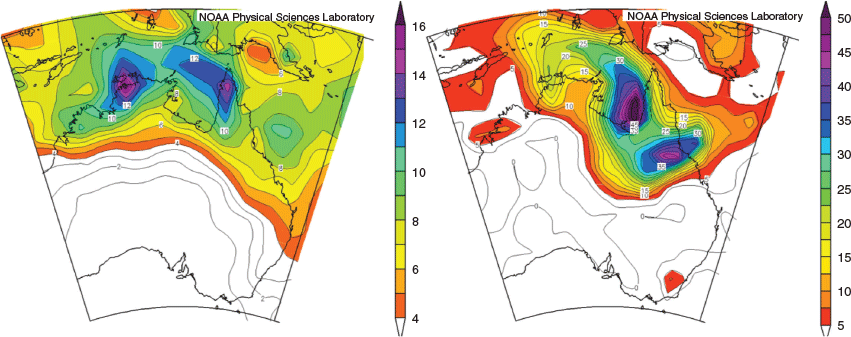
|
The actual registered rainfall shows the heavy band of rainfall extending westward from Townsville in the WAA zone (Fig. 5). The heavy rainfall in Mount Isa and southeast Gulf was mostly associated with tropical thunderstorms.
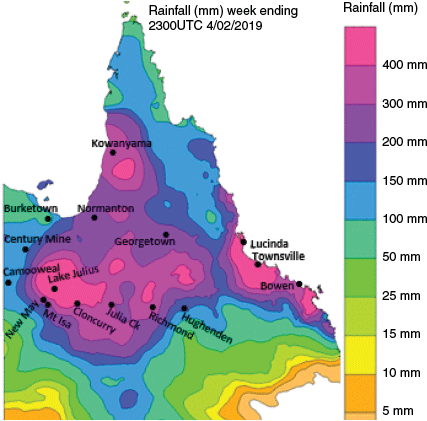
|
In Fig. 6, Townsville upper winds from 2300UTC 25 January 2019 to 2300UTC 06 February 2019 are plotted that show anticyclonic turning of the winds between 850 and 500 hPa was dominant with only two exceptions marked by the red wind plots. The corresponding rainfall in the Townsville Airport over this period was 1270.6 mm.
4 Climate drivers and predictability
The role of natural climate drivers such as El Niño–Southern Oscillation (ENSO), the Indian Ocean Dipole and Southern Annular Mode (SAM) in the event is likely to have been limited given that all were near neutral in early 2019 (Bureau of Meteorology 2019a).
The intra-seasonal tropical wave known as the Madden–Julian Oscillation (MJO) was active across the Australian region during the second half of January.
From fig. 20 in the Special Climate Statement 69 (Bureau of Meteorology 2019), sea surface temperatures (SSTs) around Townsville and the Gulf of Carpentaria showed a cooling trend to below normal during the heavy rain, so we need to understand if this was a negative factor in the rainfall generation. Lau and Wu (2011) found using Tropical Rainfall Measuring Mission data (1998–2009) that extreme rain events are most sensitive to the changes in tropical mean SST.
Cowan et al. (2019) reported that the tropical convective signal of the MJO was over the western Pacific, and likely contributed to the heavy rainfall. Over the northern Tasman Sea, an anticyclone helped maintain a positive phase of the SAM and promoted onshore easterly flow. Somewhat consistent with these climate drivers, the monthly rainfall outlook for February issued by the BOM on 31 January provided no indication of the event, yet forecasts, not available to the public, of weekly-averaged conditions by the BOM’s dynamical subseasonal-to-seasonal prediction system were more successful. For the week of 31 January to 6 February, the prediction system forecast a more than doubling of the probability of extreme (highest quintile) weekly rainfall a week prior to the event, along with increased probabilities of extremely low (lowest quintile) maximum temperatures and extreme (highest quintile) wind speeds. Ensemble-mean weekly rainfall amounts, however, were considerably underestimated by the prediction system, even in forecasts initialised at the start of the peak flooding week, consistent with other state-of-the-art dynamical prediction systems. Cowan et al. (2019) concluded that predicting this exceptional event beyond two weeks appears beyond our current capability, despite the dynamical system forecasts showing good skill in forecasting the broadscale atmospheric conditions north of Australia a week prior.
In recent times, computer forecasting models have still shown failures in forecasting extreme rainfall. Here some examples are listed in which all cases exhibited WAA structures in the heavy rainfall regions. From Callaghan (2017a), in southeast Queensland and northern New South Wales Australia, all high-resolution numerical model forecasts for TC Debbie (March 2017) underestimated the heaviest rainfall around Brisbane, southeast Queensland, and northern New South Wales while the area was affected by strong winds turning anticyclonically with height (i.e. WAA). Forecasters in Brisbane increased the amount of forecast rainfall that the models suggested for southeast Queensland based on evidence of the anticyclonic turning of the winds (T Wedd and P Otto personal communication). This had the effect of closing many schools across southeast Queensland where major flooding occurred. This wind structure was also evident for the neighbouring Tweed River area of northern New South Wales where a record flood occurred from TC Debbie claiming eight lives and the warnings were only for moderate flooding (Roads and Stormwater 2017). Forecasters responsible for this area of New South Wales adhered to the model’s forecasts and there was much criticism regarding the severity of the flooding in northern New South Wales. The BOM has described the floods that hit the Tweed as a ‘one in a thousand year event’ but the BOM national manager of flood forecasting said the BOM could not have done more. ‘This was an extraordinary event. It was a record flood at Murwillumbah’, he said. Despite forecasting much less rain than had fallen (based on model predictions), the BOM had put out warnings two days prior.
Earlier in January 2013, high-resolution models underestimated the rainfall totals for TC Oswald, with only the Australian ACCESSR model performing well and coming closest to the actual totals. This does not mean that ACCESSR is always more successful in forecasting extreme rainfall. Woo et al. (2014), demonstrated this and their fig. 24 shows how the anticyclonically turning winds with height aligned with the extreme rainfall in this event. In February 2015, models generally forecast a weak tropical low to make landfall on the central Queensland coast, which turned out to be Severe TC Marcia Category 5 (Callaghan 2017b). This occurred in an environment where the winds were turning anticyclonically with height. Cao and Zhang (2016) show that despite considerable progress in mesoscale numerical weather prediction, the ability to predict summer severe rainfall in terms of amount, location and timing remains limited because of its association with convective or mesoscale phenomena. This was the case for direct model forecasts leading up to the disastrous 2011 Brisbane River and Lockyer Valley floods, which were a third of the amount received (van den Honert and McAneney 2011). A similar situation occurred in the disastrous 2005 Mumbai Floods (Sahany et al. 2010), and in 2006 associated with one of the worst floods to affect China since 1983 (Gao et al. 2009).
At the very least it is important to understand the structure of systems which produce extreme rainfall for climate studies in projecting changes in the intensity and frequency of extreme rainfall and major flooding over coming decades. The identification of this diagnostic then focuses the attention of those responsible for flood warnings on radars in the area threatened by extreme rainfall. This can lead to early detection of the commencement of heavy rainfall which in turn leads to early warnings, so critically in the case of flash flooding in saving lives. The extreme rainfall is usually located in a convective thunderstorm complex embedded in the general heavy rain area.
The influence from global warming was considered by Zhao et al. (2020) in a modelling study that examined runoff and precipitation in the Xijiang River Basin under the background of 1.5°C and 2°C warming. They found that precipitation increases overall and more so under the high-emission and greater-warming scenarios. Disaster managers are extremely interested in how floods will affect north Queensland in the future as the planet warms. It is also important to know what occurred in the past as there will be similar events which will surely be repeated in the future. One thing is certain, as sea levels rise and population increases, coastal areas will suffer more in the future without adaptation.
5 The 2019 north Queensland floods
5.1 Overview
The rainfall caused major record flooding on the Daintree and Bloomfield Rivers on 26 January 2019. The flooding then extended to catchments further south and west including the Herbert, Ross, Bohle, Black, Haughton and Burdekin Rivers, and Bluewater Creek. Widespread major flooding was also recorded across the Gulf country including the Flinders, Cloncurry and Leichhardt Rivers.
The BOM’s site at Townsville Airport recorded 1259.8 mm in the 10 days to 8 February. Prior to this event, the Townsville record for a 7-day period was 886.2 mm (January 1998).
There were several sites in elevated areas around Townsville including Paluma, Woolshed and Upper Bluewater that reported 12-day accumulations of more than 2000 mm.
Townsville was significantly impacted, exceeding its previous flood of record by a large margin, and directly impacting thousands of properties. The Haughton River at Giru remained above the major flood level for over a week, impacting numerous main roads including the Bruce Highway.
Properties in Townsville were flooded following the heavy rains after officials were forced to open the floodgates of the Ross River Dam which reached a record-breaking 213% of its capacity on 4 February 2019.
In the Gulf country and northwest Queensland, record-breaking rainfall also occurred in previously drought affected regions, including at Julia Creek and Richmond.
These significant episodes of the flood event are described in some detail below.
5.2 Daintree region north of Cairns
The Daintree River rises in the Great Dividing Range, approximately 20 km southwest of Daintree, the largest town within the catchment. It initially flows in a northerly direction, before turning southeast passing Daintree and finally entering the Coral Sea. Floods may develop quickly and with little warning from high rainfalls on the 1000-m-high mountain ranges around the catchment.
A low-pressure system deepened on the western tip of Cape York Peninsula from 0000UTC 23 January 2019 from 1007 to 999 hPa by 1200UTC 25 January 2019. In Fig. 7 (left frame) the low can be seen on the coast between Weipa and Kowanyama at 1700UTC 25 January 2019 with a band of heavy rain on the east coast between Cooktown (12-h rainfall 93 mm) and Mossman. From Fig. 7 (right frame) the low (with a secondary centre in the Coral Sea) had moved slightly inland by 1100UTC 26 January 2019 and the band of rain had strengthened (12-h rainfall of 84 mm at Low Island and 118 mm at Cairns Airport). The ACCESS charts show the anticyclonic turning winds across Cape York and the Daintree Region between Cairns and Cooktown (Fig. 8). The HYSPLIT trajectory analyses for China Camp shows that ascent of air parcels occurred during the heavy rain period (Fig. 9).
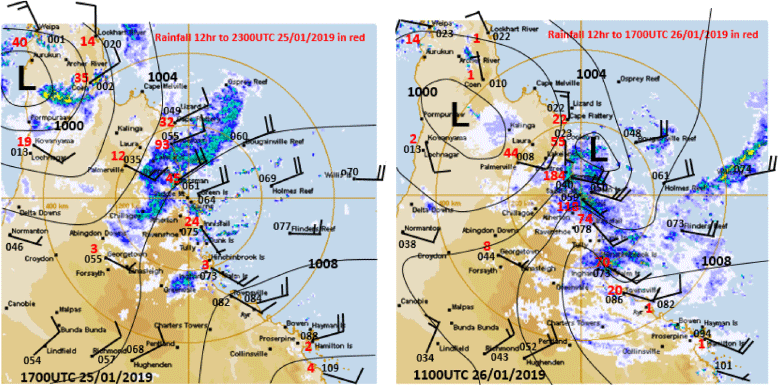
|
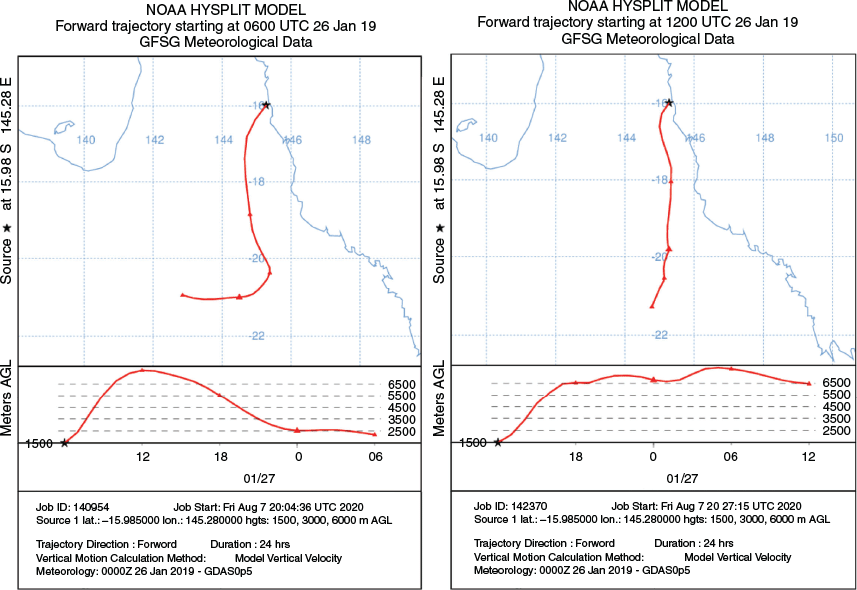
|
The Daintree River heights at Daintree Village reached 12.60 m at 1355UTC 26 January 2019 (major level 9.0 m) exceeding the 1901 record of 12.4 m. Some of the short-term intensities were less than a 1% Annual Exceedance Probability (AEP) or in other words exceeded the 100-year Average Recurrence Interval, or ARI (Bureau of Meteorology 2019). The historical daily and weekly Daintree catchment rainfalls for January 2019 were insignificant compared with earlier floods; however, it was the intense 6-hourly rainfall that caused the record flood. At China Camp, 149.0 mm was recorded in the 2 h up to 0826UTC 26 January 2019 and 241.0 mm in the 4 h to 1100UTC 26 January 2019.
5.3 Intense rainfall and flooding Townsville area 30 January and 3 February 2019
Two of the heaviest rainfall episodes at Townsville are described here. The first intense rainfall event is illustrated in Fig. 10 when the low (1002 hPa) had moved to a position near Normanton in the southeast Gulf of Carpentaria. The onshore flow into the rain area was around 20 knots (10.3 m/s) with dewpoints around 25°C on the coast. The upper winds immediately before the onset suggested isentropic ascent across the region (anticyclonic turning with height) and the short-term intense rainfall reports in Fig. 10 (lower right) reflect this strongly ascending humid tropical air steam. Bluewater Creek rose 5 m over the period of this intense rain, causing much damage due to high floods and strong river currents. Rainfall observations around Bluewater Creek were as follows: Upper Bluewater 289 mm in 6 h to 0200UTC 30 January 2019, Bluewater 148 mm in 3 h to 0200UTC 30 January 2019 and Toolakea 187 mm in 3 h to 0200UTC 30 January 2019. The air parcel trajectory analysis in Appendix 2 verified the ascent with this heavy rainfall.
The monsoon low at 1200UTC 2 February 2019 was by then a deep system with convection indicated from radar surrounding the centre where a pressure of 990 hPa was indicated (Fig. 11). Radar also showed a band of rain over Townsville. Between 2300UTC 02 February and 1100UTC 03 February 2019 during which anticyclonic turning of the winds with height was present (Fig. 6) there was extreme rainfall in the Townsville area in the 6 h from 0500UTC to 1100UTC 03 February 2019 as follows: Annandale 180.0 mm, Rooney’s Bridge 177.0 mm, South Townsville 160.0 mm, Mysterton 159.0 mm, Gordon Creek 157.0 mm, Vincent 155.0 mm and Aitkenvale 154.0 mm.
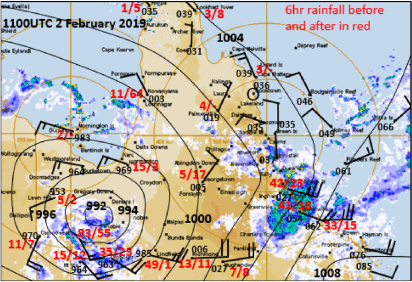
|
The Ross River Dam spillway gates above Townsville were fully opened around 0900UTC 03 February 2019 and Aplin Weir Alert (downstream of the Ross River Dam) peaked with a record major flood. Officials were forced to open the floodgates of the Ross River Dam when it reached a record-breaking 213% of its capacity on 4 February 2019. This can be seen in figs. 36 and 37 in Bureau of Meteorology (2019b). The ACCESS 700 hPa chart from 1200UTC 02 February to 1200UTC 03 February 2019 illustrates the WAA over Townsville during this period of extreme rainfall (Fig. 12). The HYSPLIT trajectory analyses in Appendix 2 confirms this ascent over Townsville.
Daily rainfall totals averaged across the whole Ross–Bohle catchment for this flood event were not overly significant compared with other historical flood events (outlined in table 46 of Bureau of Meteorology 2019). However, the weekly rainfall averaged over the catchment illustrates the significance of the multiday rainfall for the Ross–Bohle catchment recorded during this event (outlined in table 47 of Bureau of Meteorology 2019) where the 2019 event occupied the first six places in the weekly rainfall record totals.
The highest 24-h total recorded within these Ross–Bohle–Blue Rivers and Blackwater Creek catchments was at Woodlands Alert (located immediately upstream of Ross River Dam) with a total of 402 mm to 2300UTC 03 February 2019. The AEP analyses for this station indicates values of <1% for every interval from 30 min to 7 days (Bureau of Meteorology 2019).
5.4 Flinders River Catchment
There was WAA evident in the Julia Creek region (Flinders River catchment) by 0000UTC 05 February 2019 during a very heavy rainfall episode near that station (Fig. 13). The monsoon low with a central pressure reaching below 990 hPa hovered around the Gilliat River and Julia Creek region from 1100UTC to 1700UTC 4 February 2020 (Fig. 14), with Julia Creek reporting 119 mm in 12-h. The 24-h rainfall totals to 2300UTC 04 February were as follows: Gilliat River 331.0 mm, Julia Creek Ap 233.0 mm and Brinard Station 231.0 mm, all three being in the Flinders River Catchment. Several inland stations were subjected to record floods from the Flinders River. The highest event total of 700.5 mm was recorded at Hulberts Bridge.
The Gilliat River intense rainfall analyses registered an AEP of <1% for the following durations: 12 h, 24 h, and 2, 3, 4, 5, 6 and 7 day periods. The AEP analyses were obtained from the report (Bureau of Meteorology 2019). The HYSPLIT air parcel trajectory showed marked ascent about Gilliat River as the parcel circulated around the low (see Appendix 2).
6 Record historical north Queensland floods
Dare et al. (2012), using data from 1969/70 to 2009/10, showed that over north Queensland non-TC events produced more rainfall than TCs. Also, in a climatological sense, their results indicate less inland penetration of TC rainfall over north Queensland compared with Western Australia. Below we study past tropical Queensland extreme events, where in one case this penetration of extreme rainfall inland from a TC was disastrous. Other past events have produced generally unexpected rainfall rates and that a repeat of similar events in the future would cause headaches for disaster managers let alone from increased effects due to global warming. Below are examined historical record-breaking events in inland Queensland which are exceptions to the findings of Dare et al. (2012).
6.1 Inland penetration by TC – the 1916 Clermont floods
As an example of extreme inland penetration one of Australia’s worst flooding disasters occurred when a TC brought extreme rainfall into the generally dry interior of tropical Queensland. At 2300UTC 25 December 1916 a severe TC passed over the Dent Island Lighthouse just north of Mackay where a central pressure of 958 hPa was recorded. By 1100UTC 27 December 1916, the night of commencement of the flood, it was located approximately 90 km north of Clermont. Disastrous flooding occurred and the final death toll in Clermont was somewhere between 61 and 70. The lower part of the town was never rebuilt, and settlement shifted to higher ground.
In Fig. 15a the rainfall in the 24 h to 2300UTC 27 December 1916 shows extreme rainfall around Clermont. The track of the cyclone and the maximum rainfall zone is shown in Fig. 15b with selected rainfall registrations over the 24-h period up to 2300UTC 27 December 1916. Most of this rain fell over the 15-h period from 0800UTC to 2300UTC (Harman and Whittingham 1970). The heaviest rainfall was in a zone 30–60 km east of the track of the cyclone with totals to 597 mm. This rainfall bias to the east suggests a WAA wind pattern on the eastern side (or perhaps southeast side of the TC) consistent with a vortex tilted in this direction (e.g. Tory 2014). These rainfall totals are staggering for an inland location when you consider the record daily rainfall for Tully, one of the wettest locations in Australia, is 606 mm – somewhat less than the rainfall rate of 597 mm in around 15 h. Obviously, the TC kept its inner core structure intact as it made its way towards Clermont and is a sobering message for the potential inundation that is possible so far from the coast. It appears that some intensification of the system occurred as it moved inland after initially weakening following landfall.
The following event analysis gives an insight in the causes of the 1916 rainfall at Clermont. From this it seems likely that the 1916 Clermont rainfall was also associated with strong WAA.
6.2 Inland penetration by TC-like systems – the Charters Towers cyclone 2008
Early work on the development of TC-like systems in the desert areas of northern Australia include Foster and Lyons (1984), McBride (1987), Davidson and Holland (1987) and more recently Varble et al. (2014) and Tang et al. (2016). Two of these systems addressed in these papers are shown in Appendix 3, indicating how WAA was associated with their development and the occurrence of heavy rain. More of these desert storm events are illustrated in Appendix 3: one a cyclone that developed as it moved from the Darwin area down to Birdsville in southwest Queensland, producing gales there along with a long-term Australian record for heavy rain; and a series of desert cyclones which occurred in the Northern Territory during February 2001 are also inspected, which all had WAA wind structures during their intensification periods.
Emanuel et al. (2008) showed how TC-like systems with a compact radar eye could form over the sandy deserts of Central Australia. We observed this to occur in grazing country further east. Fig. 16 shows how a TC-like system, which may have been the remnants of TC Helen, developed between Townsville and Charters Towers in January 2008. The radar shows the heaviest rain east of Charters Towers which recorded 146.8 mm in the 24 h to 2300UTC 15 January 2008. Thousands of trees were reported as being downed between Townsville and Charters Towers. Charters Towers observation at 0500UTC 15 January 2008 was temperature 23°C, dewpoint 23°C, average wind southwest 96 km/h (52 knots), mslp 993.0 hPa and 109.0 mm of rain in the past 6 h.
The HYSPLIT air parcel trajectory from Townsville to Charters Towers in Appendix 2 shows parcels undergoing ascent over this track. Fig. 17 provides an alternate way to depict the WAA wind pattern. The unfilled barbs represent the 850 to 500 hPa wind shear and can be thought of as a thermal wind vector (warmer air to the left of the barb and cooler air to the right). The full barb is the 700 hPa wind, which represents the mean flow relative to the thermal gradient. The plots use European Centre Weather Forecasting diagnostics. The resultant WAA was strong with 25–30 knot (12.5–15 m/s) northeasterlies winds crossing the 25–30 knot (12.5–15 m/s) shears at right angles. The WAA dominated the circulation with weaker CAA on the western side, which is often observed during TC intensification. Over the ocean it has been found that intense TCs intensify when WAA dominates the circulation (Callaghan and Tory 2014; Callaghan 2017a, 2018, 2019a, 2019b). The veracity of all the European Centre for Medium-Range Weather Forecasts Analyses in Fig. 17 is shown by the plotted actual radiosonde wind and shear data. This strong and widespread WAA followed the cyclone south into the central highlands (right frame and lower left frame) where Bogantungan (see Fig. 1) reported 329 mm in 24 h to 0051UTC 17 January 2008 (ARI rainfall 500 year) 453 mm in 48 h to 1105UTC 17 January 2008 (ARI 500–1000 year) and 604 mm in 72 h to 1625UTC 18 January 2008 (ARI > 2000 years). Peakvale and Anakie had similar rare rainfall intensities, and all three stations are in the Nogoa River Catchment where record floods were reported. Moist tropical air reached this area with the Clermont synoptic station having a dewpoint of 24°C over the period.
For the Bogantungan, Anakie and Peakvale analyses see BOM 2008 report: http://www.bom.gov.au/qld/flood/fld_reports/Central_and_Western_QLD_Floods_January_2008.pdf. The HYSPLIT trajectory analyses for ascent in the Bogantungan region is shown in Appendix 2 and shows strong ascent over Bogantungan at 0600UTC 16 January 2008, 0500UTC 17 January 2008 and 0400UTC 18 January 2008.
6.3 Inland penetration by the 1958 Bowen Cyclone – Burdekin Floods
Widespread dislocation of traffic and communications was reported on the central coast because of flooding in the wake of a severe TC which struck Bowen on 1 April 1958 and the extreme rainfall then penetrated well inland (Fig. 18). Record peaks occurred in the Bowen River on 2 April and in the Bogie River on 3 April. Some homesteads were carried away and their occupants isolated, roads and bridges extensively damaged, and thousands of cattle lost. From Fig. 18 the heavy rainfall moved overland into the Burdekin River catchment and subsequent flooding of the lower Burdekin River also broke all records. Goods were damaged when Home Hill and Ayr were inundated, the water being 2 m deep in the main street of Home Hill at one time. Many cane farms were seriously damaged, three spans of the old railway bridge at Home Hill were washed away and approaches to the new high-level bridge cut. Restoration of riverbanks on the Burdekin was costly. Record peaks were recorded on the Bowen and Burdekin Rivers at several locations on 3 April: Birralee, Dalbeg, Strathalbyn and Home Hill (Inkerman Bridge).
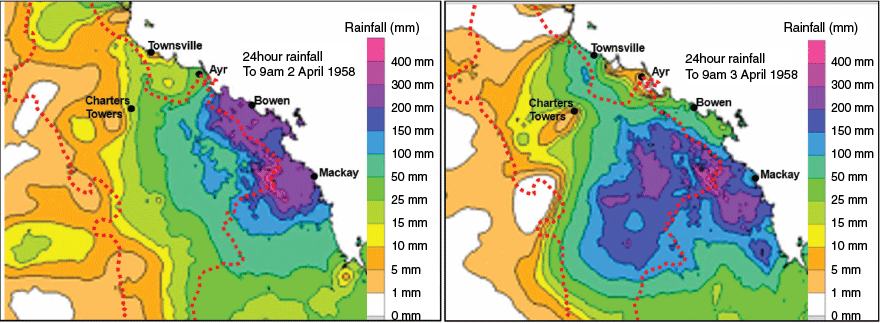
|
Torrential rain caused record floods in other southern tributaries of the Burdekin on 6 April. Heights on the Suttor River reached 3–4.5 m above the levels thought by local inhabitants to be the flood extreme. Unofficial rain gauges recorded as much as 500 mm in 10 h and the river was 35 km wide in places. Homesteads which had never been affected by floodwaters were almost submerged and some were carried away. Bridges were destroyed and roads damaged by scouring up to 5 m deep. The Pioneer River was also in high flood on 2 and 3 April, causing the evacuation of 60 homes at Mackay.
6.4 Coastal heavy rain occurring from a TC – record Fitzroy River flood
In this case, like that reported by Dare et al. (2012), the heaviest rain remained near the coast as the cyclone moved well inland and therefore contrasts with the 1916 Clermont flood. This 1918 cyclone made landfall at Mackay (Bath 1957) where a pressure of 932.6 hPa was read. The cyclone made landfall at Mackay at 2100UTC 20 January 1918 and moved in a general westerly direction until 2300UTC 25 January 1918 when it was located in the Northern Territory. The record flood of 10.11 m occurred at Rockhampton 0100UTC 24 January 1918. The rainfall on the Fitzroy River catchment leading up to the flood was dominated by catchment rainfall closer to the coast (see Fig. 19). At least 30 people died in Mackay and Rockhampton when the flood in Rockhampton reached a record level which still stands today, damaging 1400 homes and drowning six people.
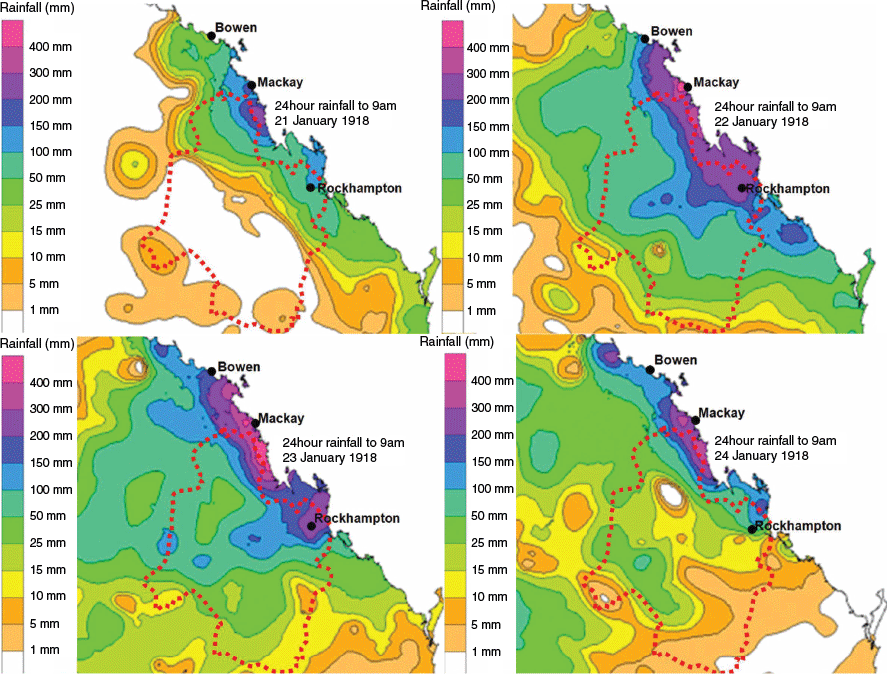
|
6.5 Coastal heavy rain occurring from a TC and a developing TC – Cairns 1965 and 1977
Table 1 shows a relationship between wind data and rainfall using more than 50 years of wind data at Cairns (latitude 16.9°). The levels were chosen after studying hundreds of heavy rain and TC cases and a strong relationship was found at that station between the WAA-type profile (winds turning anticyclonic from 850 up to 500 hPa) and heavy rainfall. This was the case during March 1967 around Cairns when a strong monsoon trough lay across the station as TC Elaine was developing into a cyclone just to the east of Cairns, and torrential rain fell in the north coast Herbert and Barron Divisions. The major feature of the months flooding was the record flooding in the Herbert. Falls of up to 1321 mm in 4 days in the Barron and Herbert districts produced the highest flood on record in the Herbert River. Near record flooding was also reported in the Barron, Johnstone and Tully Rivers. Similarly, during March 1977, TC Otto brought record floods in the Barron River in Cairns.
6.6 Extreme rainfall from extratropical transition – ex TC Oswald 2013 and ex TC Sid 1998
Both events occurred when the remnants of TCs interacted with deep layered trough systems in a similar way to extratropical transition events (Jones et al. 2003) and the rainfall in both cases was characterised by winds which turned anticyclonic from 850 up to 500 hPa. From Leroux et al. (2020) a record daily rainfall of 348.0 mm was recorded at Rockhampton on 25 January 2013 when ex TC Oswald moved down through eastern Queensland. A total of 6500 properties across 90 towns were either damaged or uninhabitable across Queensland, costing an estimated A$2.4 billion. In tropical regions, major floods occurred in the Herbert, Haughton and Fitzroy Rivers while record floods occurred just south of the tropics at Baffle Creek and Bundaberg.
A record major flood occurred (Bureau of Meteorology 1998) when ex TC Sid struck the Townsville area in January 1998. The rainfall intensity at Townsville was greater than that of the 2019 event. The rainfall intensity for all durations from 1 to 24 h significantly exceeded the 100-year ARI (significantly less than the 1% AEP). The 24-h total at Townsville at 2300UTC 10 January 1998 was 548.8 mm, which stands as Townsville’s record. There were WAA winds recorded at Townsville leading to the heaviest rainfall (Bureau of Meteorology 1998). There were larger 24-h totals to 2300UTC 10 January 1998 around Townsville including 742.0 mm at Railway Estate and 735.0 mm at Vincent. The effect of this intense rainfall in 1998 was destructive flash flooding.
6.7 Extreme rainfall from a tropical low – Mackay 1958
During February 1958, Mackay experienced a record flood of 9.14 m. This event produced remarkably heavy rain over short periods. For example, Mt Pelion (on the coastal plains) near Mackay reported 292 mm in 2.5 h and 589 mm in 6 h overnight on the 17/18 February 1958. Other rain gauges in the Mt Pelion area overflowed at 30 inches (762 mm) that night. In the same region at Elaroo, 533 mm was recorded in 5 h before the gauge overflowed. A nearby farm recorded 914 mm in just over 8 h. The observers noted that the heaviest rain was associated with thunderstorms (Brunt 1958).
Three people died in floods in the Mackay area, while 20 houses were washed away and there was severe damage to infrastructure including two bridges. After being inundated for 12 h, Foulden (population 250) was destroyed and property owners lost all their possessions. All houses were totally wrecked, three being washed out to sea. Most of the population sought refuge on the roofs of their homes, only to find them being washed away and many narrow escapes from drowning were reported. The flood left great depths of silt which completely covered the town by up to 3 m. In places only the tops of telephone poles were showing. All communications were cut, and cane crops were destroyed. The synoptic situation was like that at Townsville in 1998, with a monsoon low near Mackay and an upper low to the west of Mackay. The heaviest rain fell in the onshore flow south of the monsoon trough. Mackay had no upper air observations at that time although examination of the upper winds at Gladstone gave some insight into the three-dimensional WAA structure in the winds south of the monsoon trough. The winds at Gladstone at 2300 UTC 16 February 1958 were 850 hPa east-northeast winds turning anticyclonic with height to 500 hPa northerlies.
6.8 Prolonged extreme rainfall – Gulf of Carpentaria 1974
The 1974 Gulf flood was a record in the lower reaches of the Norman and Leichardt Rivers and the second highest in the lower reaches of the Gilbert and Flinders Rivers. About 560 Normanton residents, almost the entire population, were evacuated on January 24 with 460 to Cairns and the rest to Mount Isa. On 14 February 1974, Normanton residents began returning to their homes after the biggest floods the Gulf country had known that century. Prior to 1974, the most severe floods since settlement of the region occurred in the summer of 1869–70 (Simpson and Dautch 1977).
It rained at Normanton consistently throughout November and December 1973; during 3–17 January 1974 the town recorded 388.0 mm, and in the 48 h to 9 am 19 January 244.1 mm was recorded. The heaviest rain fell at Normanton during 17–23 January 1974 when a monsoon trough extended across the continent from 20°S to 23°S with strong north-westerly monsoon winds flowing in from the north. The main low-pressure centre in the trough over this period moved from near Alice Springs to the central interior of Western Australia.
7 Conclusion
This is the first paper to address the anticyclonic turning of the winds with height (WAA phenomena) in causing monsoon and TC floods in the northeast Australian tropics and in TC-like systems that develop over the interior of northern Australia and are capable of producing extreme rainfall, which help explain Australia’s worst tropical flooding disaster. We have earlier addressed floods from WAA in southeast Australia and around the globe, and extreme rainfall in US hurricanes and Australian TCs.
Record-breaking rainfall and flooding occurred over tropical north Queensland in late January early February 2019 without favourable influences from some of the major climate drivers or from SSTs over adjacent seas. The main influences for the heavy precipitation were a stronger monsoon surface circulation than normal over northern Australia and a stronger mean sea level subtropical ridge over New Zealand, which both combined to produce above average general easterly flow south of the monsoon trough. Combined with this was a vertical atmospheric structure that caused the winds to turn in an anticyclonic sense from around 1.5 km elevation and, where there was a large tropical moisture content, up to around 5.8 km elevation. This wind structure is associated with isentropic ascent and is often referred to as WAA (Tory 2014). The rainfall fell for lengthy periods in this WAA region due to the slow movement of a low-pressure system, which after a time became quite intense. The slow movement was associated with a symmetric structure around the low having strong deep monsoon westerlies to its north and strong deep easterlies to its south. The resultant flooding caused loss of human lives and an unprecedented loss of livestock. The event was compared with earlier historical events in north Queensland and some of these showed rainfall rates far greater than those in 2019. A flood in Clermont during 1916 caused by extraordinary rainfall (seldom experienced even in tropical coastal areas) resulted in the loss of up to 70 lives. The same general region experienced another event during January 2008 and rainfall rates were analysed as greater than a one in 2000-year event. The data associated with the 2008 event suggested that such extreme rainfall rates, and the development of a TC-like weather system in the usually dry tropical interior was from strong and widespread WAA overlying humid tropical air masses. The dynamics of this system along with several other events mentioned in Appendix 3 allow us to speculate on what caused the extraordinary rainfall at Clermont in 1916. The other past events were all associated with record north Queensland floods and only two, the 1974 Gulf flood and the 1958 Mackay flood had no TC interaction.
Conflicts of interest
The author declares no conflicts of interest.
Declaration of funding
No funding was received for this study.
Acknowledgements
The three anonymous reviewers provided excellent guidance to progress this paper into a publishable form. Samantha Taylor produced the statistical data in Table 1 from the Bureau of Meteorology national archives.
References
Adekunle, A. I., Adeqboye, O. A., and Rahman, K. M. (2019 Apr). Flooding in Townsville, North Queensland, Australia, in February 2019 and Its Effects on Mosquito-Borne Diseases. Int. J. Environ Res Public Health 16, 1393.| Flooding in Townsville, North Queensland, Australia, in February 2019 and Its Effects on Mosquito-Borne Diseases.Crossref | GoogleScholarGoogle Scholar |
Anjaria, J. S. (2006). Urban Calamities: A View from Mumbai. Space and Culture 9, 80–82.
| Urban Calamities: A View from Mumbai.Crossref | GoogleScholarGoogle Scholar |
Bath, A. T. (1957). The Mackay cyclone of 21 January 1918. Australian Met. Magazine 19, 46–59.
Blake, E. S., and Zelinsky, D. A. (2018). National Hurricane Center Tropical Cyclone Report Hurricane Harvey (2017). Available at https://www.nhc.noaa.gov/data/tcr/AL092017_Harvey.pdf
Bonell, M., and Callaghan, J. (2008). The synoptic meteorology of high rainfalls and the storm runoff response in the wet tropics. In ‘Living in a Dynamic Tropical Forest Landscape.’ (Eds N. Stork and S. Turton). Blackwell
Bonell, M., Callaghan, J., and Connor, G. (2005). Synoptic and mesoscale rain producing systems in the humid tropics. In ‘Forests, Water and People in the Humid Tropics International Hydrological Series’ (Eds M. Bonell, and L. A. Bruijnzeel). pp 194–266. (Cambridge University Press)
Brunt, A. T. (1958). The Mackay Storm February 1958, Conference on estimation of extreme precipitation, Melbourne April 1958.
Bureau of Meteorology (1998). Severe weather and flooding North Queensland January 1998. Available at www.bom.gov.au/qld/flood/fld_reports/nth_qld_jan1998.pdf
Bureau of Meteorology (2010). Special Climate Statement 20 A significant rainfall event for central and eastern Australia. Available at http://www.bom.gov.au/climate/current/statements/scs20a.pdf
Bureau of Meteorology (2019a). Bureau of Meteorology Special Climate Statement 69—an extended period of heavy rainfall and flooding in tropical Queensland. Available at http://www.bom.gov.au/climate/current/statements/scs69.pdf
Bureau of Meteorology (2019b). North Queensland Monsoon Technical Flood Report 2019. Available at http://www.bom.gov.au/qld/flood/fld_reports/QLD_Monsoon_Trough_floods.pdf
Callaghan, J. (2017a). A Diagnostic from Vertical Wind Profiles for Detecting Extreme Rainfall. Tropical Cyclone Res. Rev. 6, 41–54.
Callaghan, J. (2017b). Asymmetric Inner Core Convection Leading to Tropical Cyclone Intensification. Tropical Cyclone Res. Rev. 6, 55–66.
Callaghan, J. (2018). A Short Note on the Rapid Intensification of Hurricanes Harvey and Irma. Tropical Cyclone Res. Rev. 7, 164–171.
Callaghan, J. (2019a). A short note on the intensification and extreme rainfall associated with hurricane Lane. Tropical Cyclone Res. Rev. 8, 103–107.
| A short note on the intensification and extreme rainfall associated with hurricane Lane.Crossref | GoogleScholarGoogle Scholar |
Callaghan, J. (2019b). The interaction of hurricane Michael with an upper trough leading to intensification right up to landfall. Tropical Cyclone Res. Rev. 8, 95–102.
| The interaction of hurricane Michael with an upper trough leading to intensification right up to landfall.Crossref | GoogleScholarGoogle Scholar |
Callaghan, J. (2020). Extreme rainfall and flooding from hurricane Florence. Tropical Cyclone Res. Rev. 9, 172–177.
| Extreme rainfall and flooding from hurricane Florence.Crossref | GoogleScholarGoogle Scholar |
Callaghan, J., and Tory, K. (2014). On the use of a system-scale ascent/descent diagnostic for short-term forecasting of Tropical Cyclone development, intensification, and decay. Tropical Cyclone Res. Rev. 3, 78–90.
Callaghan, J., and Power, S. B. (2016). A vertical wind structure that leads to extreme rainfall and major flooding in southeast Australia. J. South. Hemisph. Earth Syst. Sci. 66, 380–401.
| A vertical wind structure that leads to extreme rainfall and major flooding in southeast Australia.Crossref | GoogleScholarGoogle Scholar |
Cao, Z., and Zhang, D.-L. (2016). Analysis of two missed summer heavy rainfall events. Analysis of missed summer severe rainfall forecasts. Wea. Forecasting 31, 433–450.
| Analysis of two missed summer heavy rainfall events. Analysis of missed summer severe rainfall forecasts.Crossref | GoogleScholarGoogle Scholar |
Cowan, T., Wheeler, M. C., Alves, O., Narsey, S., de Burgh-Day, C., Griffiths, M., Jarvis, C., Cobon, D. H., and Hawcroft, M. K. (2019). Forecasting the extreme rainfall, low temperatures, and strong winds associated with the northern Queensland floods of February 2019. Wea. Clim. Extremes 26, 100232.
| Forecasting the extreme rainfall, low temperatures, and strong winds associated with the northern Queensland floods of February 2019.Crossref | GoogleScholarGoogle Scholar |
Czajkowski, J., Villarini, G., Montgomery, M., Michel-Kerjan, E., and Goska, R. (2017). Assessing Current and Future Freshwater Flood Risk from North Atlantic Tropical Cyclones via Insurance Claims. Nature Scientific Reports 7, 41609.
| Assessing Current and Future Freshwater Flood Risk from North Atlantic Tropical Cyclones via Insurance Claims.Crossref | GoogleScholarGoogle Scholar |
Dare, R. A., Davidson, N. E., and McBride, J. L. (2012). Tropical cyclone contribution to rainfall over Australia. Mon. Wea. Rev. 140, 3606–3619.
| Tropical cyclone contribution to rainfall over Australia.Crossref | GoogleScholarGoogle Scholar |
Davidson, N. E., and Holland, G. H. (1987). A diagnostic analysis of two intense monsoon depressions over Australia. Mon. Wea. Rev. 115, 380–392.
| A diagnostic analysis of two intense monsoon depressions over Australia.Crossref | GoogleScholarGoogle Scholar |
Emanuel, K., Callaghan, J., and Otto, P. (2008). Hypothesis for the Redevelopment of Warm-Core Cyclones over Northern Australia. Mon. Wea. Rev. 136, 3863–3871.
| Hypothesis for the Redevelopment of Warm-Core Cyclones over Northern Australia.Crossref | GoogleScholarGoogle Scholar |
Foster, I. J., and Lyons, T. J. (1984). Tropical cyclogenesis: A comparative study of two depressions in the northwest of Australia. Quart. J. Roy. Meteorol. Soc. 110, 105–119.
| Tropical cyclogenesis: A comparative study of two depressions in the northwest of Australia. Quart.Crossref | GoogleScholarGoogle Scholar |
Gao, S., Meng, Z., Zhang, F., and Bosart, L. F. (2009). Observational Analysis of Heavy Rainfall Mechanisms Associated with Severe Tropical Storm Bilis (2006) after its Landfall. Mon. Wea. Rev. 137, 1881–1897.
| Observational Analysis of Heavy Rainfall Mechanisms Associated with Severe Tropical Storm Bilis (2006) after its Landfall.Crossref | GoogleScholarGoogle Scholar |
Goff, J. M., and Hanson, G. A. (2012). Flash Flood Composite Analysis in Vermont and Northern New York. NOAA/National Weather Service Eastern Region Technical Attachment No. 2012-03 November 2012. Available at https://repository.library.noaa.gov/view/noaa/6625
Harman B., and Whittingham H. E. (1970 ). A documentary and investigation of the Clermont storm, December 1916. Irrigation and Water Supply Commission Queensland, 50 p
Holton, J. R. (2004). ‘An Introduction to Dynamic Meteorology.’ Elsevier Academic Press.
Jones, S. C., Harr, P. A., Abraham, J., Bosart, L. F., Bowyer, P. J., Evans, J. L., Hanley, D. E., Hanstrum, B. N., Hart, R. E., Lalaurette, F. O., Sinclair, M. R., Smith, R. K., and Thorncroft, C. (2003). The extratropical transition of tropical cyclones: Forecast challenges, current Understanding, and future directions. Wea. Forecasting 18, 1052–1092.
| The extratropical transition of tropical cyclones: Forecast challenges, current Understanding, and future directions.Crossref | GoogleScholarGoogle Scholar |
Lau, K.-M., and Wu, H.-T. (2011). Climatology and changes in tropical oceanic rainfall characteristics inferred from Tropical Rainfall Measuring Mission (TRMM) data (1998–2009). Journal of Geophysical Research 116, D17.
| Climatology and changes in tropical oceanic rainfall characteristics inferred from Tropical Rainfall Measuring Mission (TRMM) data (1998–2009).Crossref | GoogleScholarGoogle Scholar |
Leroux, M.-D., Nguyen-Hankinson, M. C., Davidson, N. E., Callaghan, J., Tory, K., Wain, A., and Huang, X. (2020). Environmental Interactions During the 2 Extreme Rain Event associated with ex Tropical Cyclone Oswald (2013). J. South. Hemisph. Earth Syst. Sci. 69, 216–238.
| Environmental Interactions During the 2 Extreme Rain Event associated with ex Tropical Cyclone Oswald (2013).Crossref | GoogleScholarGoogle Scholar |
McBride, J. L. (1987). The Australian summer monsoon. In ‘Monsoon Meteorology’ (Eds C. P. Chang and T. N. Krishnamurti). pp. 203–231. (Oxford University Press: New York)
Ogge, M. (2019). The National Climate Disaster Fund. The Australia Institute, Canberra. Available at https://apo.org.au/sites/default/files/resource-files/2019-12/apo-nid272046.pdf
Roads and Stormwater (2017). Tweed Shire Council March 2017 Flood.
Sahany, S., Venugopal, V., and Nanjundiah, R. S. (2010). The 26 July 2005 heavy rainfall event over Mumbai: numerical modelling aspects. Meteorol. Atmos. Phys. 109, 115–128.
| The 26 July 2005 heavy rainfall event over Mumbai: numerical modelling aspects.Crossref | GoogleScholarGoogle Scholar |
Simpson, C. J., and Dautch, H. F. (1977). The 1974 wet season flooding of the southern Carpentaria Plains, northwest Queensland. Bur. Min. Res. J. Aust. Geol. Geophys. 2, 43–51.
Stewart, S. R., and Berg, R. (2019). National Hurricane Center Tropical Cyclone Report Hurricane Florence. Available at https://www.nhc.noaa.gov/data/tcr/AL062018_Florence.pdf
Tang, S., Smith, R. K., Montgomery, M. T., and Ming, G. (2016). Numerical study of the spin-up of a tropical low over land during the Australian Monsoon. Quart. J. Roy. Meteorol. Soc. 142, 2021–2032.
| Numerical study of the spin-up of a tropical low over land during the Australian Monsoon.Crossref | GoogleScholarGoogle Scholar |
Tory, K. (2014). The turning winds with height thermal advection rainfall diagnostic: why does it work in the tropics? Aust. Meteorol. Oceanogr. J. 64, 231–238.
| The turning winds with height thermal advection rainfall diagnostic: why does it work in the tropics?Crossref | GoogleScholarGoogle Scholar |
van den Honert, R. C., and McAneney, J. (2011). The 2011 Brisbane Floods: Causes, Impacts and Implications. Water 3, 1149–1173.
| The 2011 Brisbane Floods: Causes, Impacts and Implications.Crossref | GoogleScholarGoogle Scholar |
Varble, A., Zipser, E. J., Fridlind, A. M., Zhu, P., Ackerman, A. S., Chaboureau, J.-P., Fan, J., Hill, A., Shipway, B., and Williams, C. (2014). Evaluation of cloud-resolving and limited area model intercomparison simulations using TWP-ICE observations: 1. Deep convective updraft properties. J. Geophys. Res. Atmos. 119, 13919–13945.
| Evaluation of cloud-resolving and limited area model intercomparison simulations using TWP-ICE observations: 1. Deep convective updraft properties.Crossref | GoogleScholarGoogle Scholar |
Woo, W.-C., Hogsett, W., Mohapatra, M., Nagata, K., Otto, P., Qi, L., Vo, V. H., and Xu, Y. (2014). Challenges and Advances related to TC Rainfall Forecast. In ‘Third International Workshop on Tropical Cyclone Landfall Processes (IWTCLP-III), Jeju, and 8–10 Nov 2014’.
Zhao, Y., Li, Z., Cai, S., et al. (2020). Characteristics of extreme precipitation and runoff in the Xijiang River Basin at global warming of 1.5°C and 2°C. Nat. Hazards 101, 669–688.
| Characteristics of extreme precipitation and runoff in the Xijiang River Basin at global warming of 1.5°C and 2°C.Crossref | GoogleScholarGoogle Scholar |
Appendix 1. Warm-air advection (WAA) in the 2019 monsoon circulation
Actual observation (black and red wind plots) augmented by computer generated wind analyses (yellow and green wind plots) are used to show in Fig. A1 how a cold air pool extended up into the eastern Australian inland subtropics. The cold pool extended from a thermal trough system extended northwards from higher latitudes, indicating an injection of cooler middle level air from passing southern weather systems. At the same time warm air formed around the cyclonic circulation near the Gulf of Carpentaria. The juxtaposition of these two air masses produced the WAA (marked by red circles on the wind plots) and cold-air advection (blue circles) wind structures in the east Australian region. The 850 to 500 hPa thickness contours are used to approximate 700 hPa temperature contours.
Appendix 2. NOAA HYSPLIT model analyses
In Fig. 9 forward trajectories from the NOAA HYSPLIT model were employed to help verify ascent occurrences from warm-air advection analyses. In Fig. A2 further such HYSPLIT analyses are used to verify subsequent warm-air advection charts.
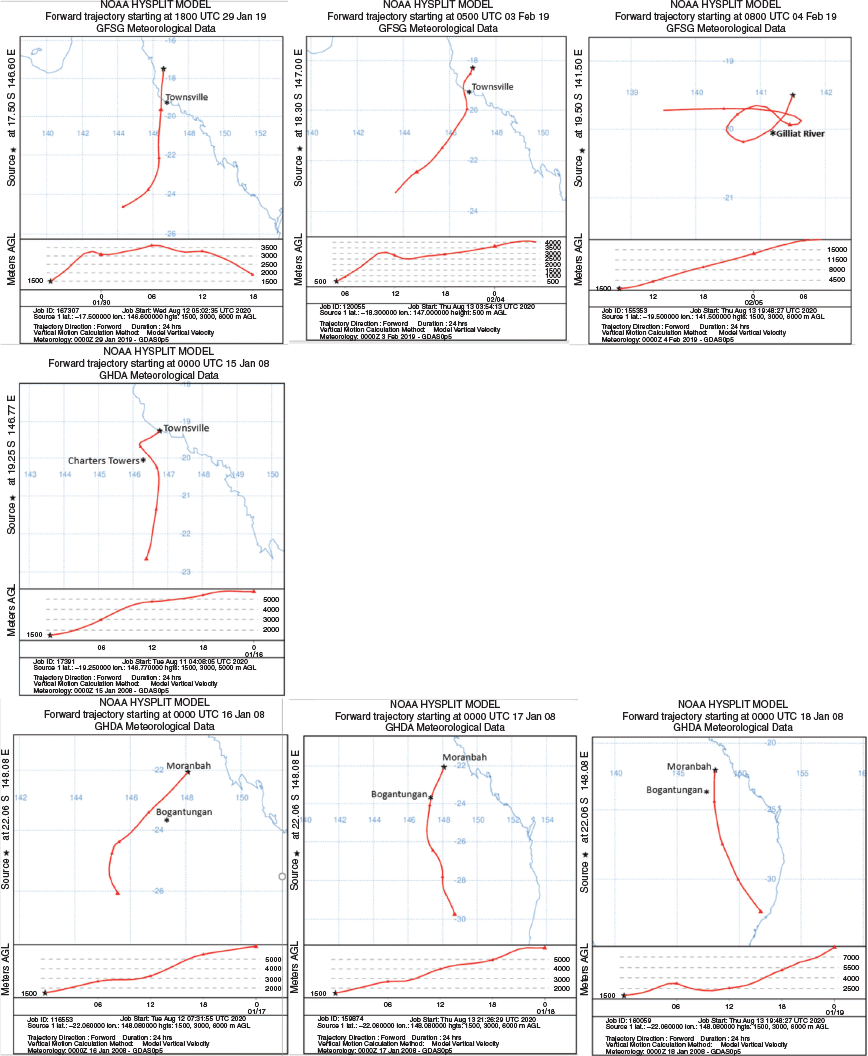
|
Appendix 3. TC-like vortices with warm-air advection (WAA) structure over inland parts of northern Australia
These inland cyclones from more recent data appear to be associated with WAA and are responsible for very heavy rainfall.
A3.1 The March 1983 tropical low mentioned in Davidson and Holland (1987)
The 1982–1983 Australian drought is regarded as the worst of the twentieth century for short-term rainfall deficiencies of up to one year and their overall impact. There were severe dust storms in north-western Victoria and severe bushfires in south-east Australia in February with 75 people killed. The El Niño-related drought ended in March, when this monsoon depression swept across Australia’s interior and on to the south-east in mid- to late March.
Other effects included:
The Alice Springs radar observations indicated strong WAA with 850 hPa east to northeast winds turning around to 500 hPa north-westerlies and averaging around 15 m s−1 from 2300UTC 15 March 1983 to 0500UTC 17 March 1983, while Alice Springs recorded 261.0 mm in the 48 h to 2300UTC 17 March 1983, generating a major flood in the Todd River.
Bundaberg Queensland recorded 221.0 mm in the 24 h to 2300UTC 20 March 1983 (a new daily March record).
Sydney Airport radar observations from 0000UTC 20 March 1983 to 1800UTC 20 March 1983 indicated WAA from northeast to east winds at 850 hPa turning northeast to north-northeast at 500 hPa. The station recorded 153.6 mm in 48 h to 2300UTC 20 March 1983 and a major flood was generated in the Georges River.
In the NSW south coast Nowra, winds indicated WAA from 1700UTC 19 March 1983 to 0000UTC 21 March 1983 and an all-time daily rainfall record occurred at Tuross 119.0 mm in 24 h to 2300UTC 20 March 1983 and 297.7 mm in 24 h to 2300UTC 21 March 1983.
All-time records of rainfall in Victoria (Otway Ranges) were recorded at Tanybryn on 22 March 1983, 24 h rainfall of 375 mm, and Tanybryn 23 March 1983, 48 h rainfall of 458 mm, which was associated with WAA at Mt Gambier, Launceston and Melbourne radar observations.
A3.2 The January 2006 cyclone
This system underwent a period of intensification over the Tanami Desert near Rabbit Flat, which is the period of interest for this study. The lowest pressure recorded at Rabbit Flat was 986.9 hPa at 0500UTC 31 January 2006. The maximum wind gust recorded at Rabbit Flat was 49 knots at 1137UTC 31 January 2006. Wind gusts caused structural damage and uprooted trees at Rabbit Flat. In 3 days, Rabbit Flat recorded 303 mm of rain. It recorded 116 mm in 12 h when near the eye of the cyclone, which ensured that the 24-h total of 165 mm to 2300UTC 31 January 2006 was a record. The heaviest rainfall was on the western side of the cyclone in the WAA area with only light rain in the cold-air advection region (see Fig. A3 left).
A3.3 The Birdsville cyclone
Fig. A3 lower left frame shows an EC diagnostic indicating an extensive area of WAA (hatched areas) as the cyclone was intensifying and moving towards Birdsville. The lower right frame shows the cyclone at peak intensity with Birdsville recording 10-min mean winds of 47 knots. Humid air from the tropics had worked its way down to Birdsville with the dewpoint there 19°C during the heavy rain. The most remarkable aspect of this event was the area covered by the heavy rainfall and the total volume of rainfall that fell. Daily rainfall totals exceeded 100 mm over 1.7% of Australia on 1 March 2010 and 1.9% on 2 March 2010. The latter is the largest area of 100 mm-plus daily totals on a single day in the Australian meteorological record, breaking the previous record of 1.7% set on the 22 December 1956 (Bureau of Meteorology 2010). The wettest day on record for Queensland was 2 March 2010 with a state-wide average rainfall of 31.74 mm, exceeding the previous record of 31.49 mm set on 21 May 1981. 28 February was the wettest day on record for the Northern Territory with an NT-wide average of 29.23 mm.
A3.4 Other cyclones overland
TC Wylva had a WAA wind structure at 0000UTC 17 February 2001 and 0000UTC 18 February 2001 as it intensified while moving across the Northern Territory desert area.
TC Winsome was similar with WAA from 13 February 2001 and 0000UTC 14 February 2001.
TC Abigail (Emanuel et al. 2008) followed a similar path while intensifying and exhibiting the WAA structure. The charts from these cyclones are available from the author.

